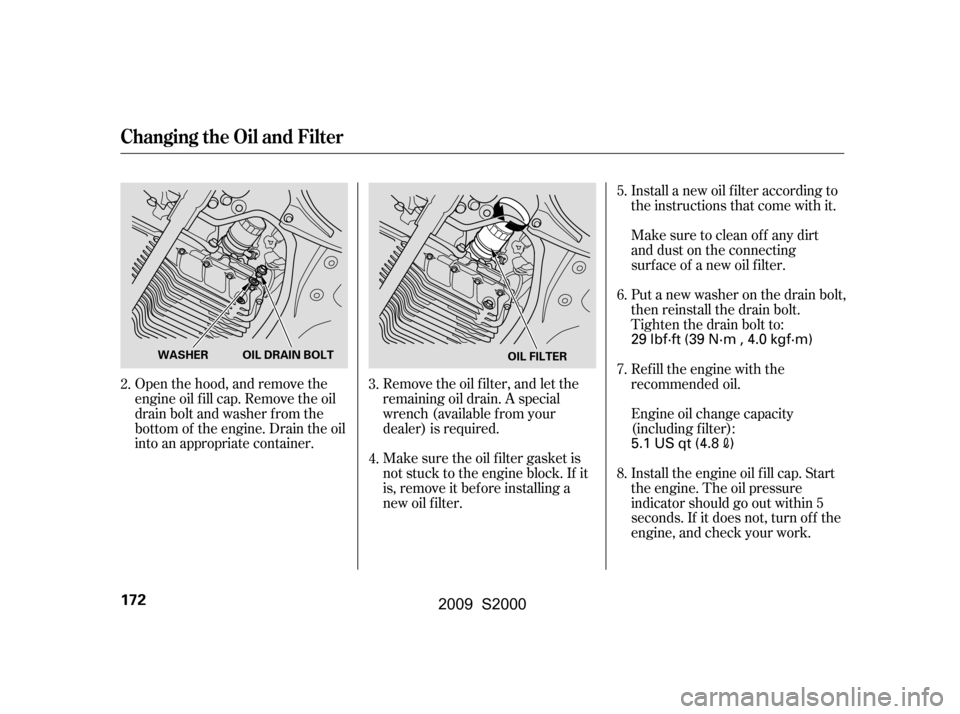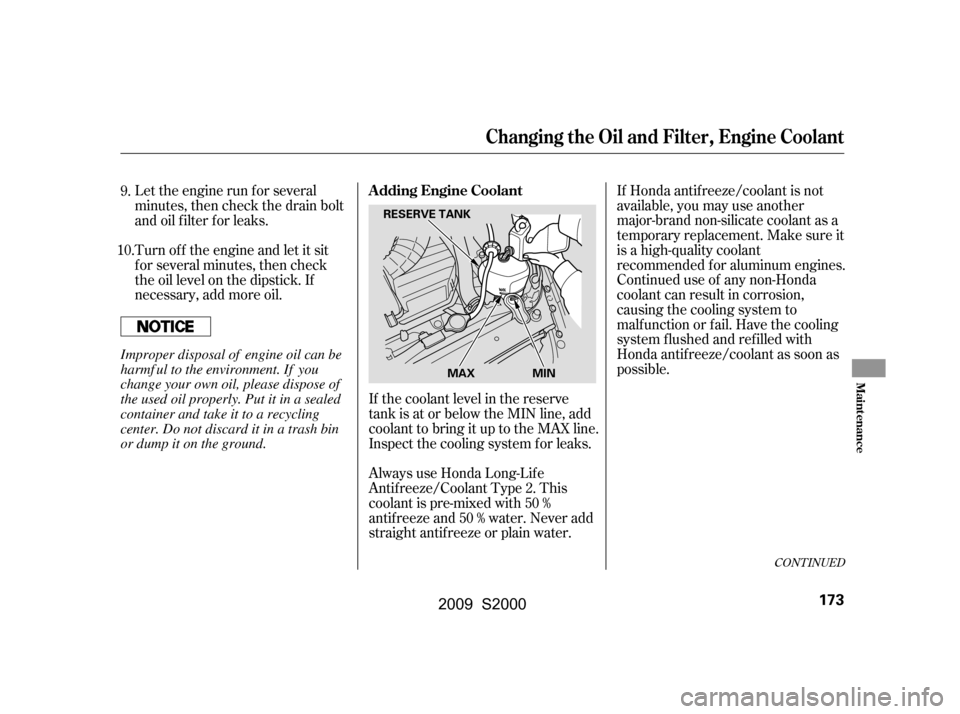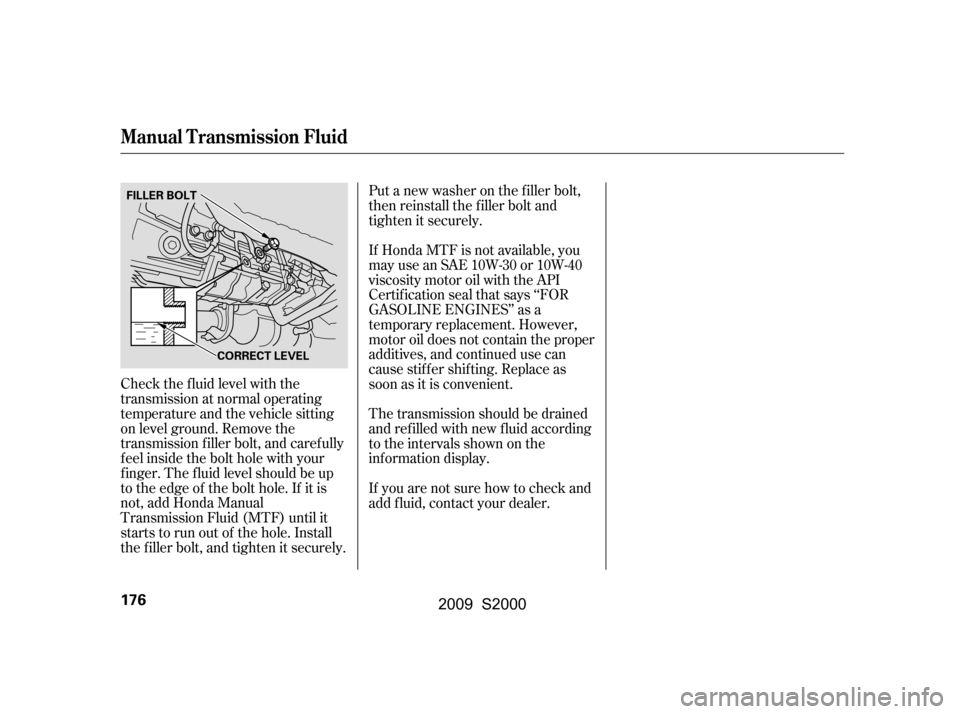Page 173 of 268
Make sure the API Certif ication Seal
says ‘‘For Gasoline Engines.’’
Oil is major contributor to your
engine’s perf ormance and longevity.
Always use a premium-grade
detergent oil displaying the API
certif ication seal. This seal indicates
the oil is energy conserving, and that
it meets the American Petroleum
Institute’s latest requirements. It is
highly recommended that you use
Honda motor oil in your vehicle f or
as long as you own it.
Unscrew and remove the engine oil
fill cap on the valve cover. Pour in
the oil slowly and caref ully so you do
not spill any. Clean up any spills
immediately. Spilled oil could
damage components in the engine
compartment. Reinstall the engine
oil f ill cap, and tighten it securely.
Wait a f ew minutes, and recheck the
oil level on the engine oil dipstick.
Do not f ill above the upper mark; you
could damage the engine. Recommended Engine Oil
A dding Engine Oil
170
API CERTIFICATION SEAL
2009 S2000
Page 174 of 268

�µ
The oil’s viscosity or weight is
provided on the container’s label.
Select the oil f or your vehicle
according to this chart.
An oil with a viscosity of 10W-30 is
pref erred f or optimum f uel economy
and year-round protection in your
vehicle. You may use 5W-40 oil if the
temperature in your area goes below
0°F ( 20°C).
Your vehicle does not require any oil
additives. Additives may adversely
af f ect the engine or transmission
perf ormance and durability.
You may use a synthetic motor oil if
it meets the same requirements
given f or a conventional motor oil: it
displays the API Certif ication Seal,
and it is the proper weight. You must
f ollow the oil and f ilter change
intervals shown on the information
display.
Always change the oil and f ilter
according to the maintenance
messages shown on the inf ormation
display. The oil and f ilter collect
contaminants that can damage your
engine if they are not removed
regularly.
Run the engine until it reaches
normal operating temperature,
then shut it off.
Changing the oil and f ilter requires
special tools and access f rom
underneath the vehicle. The vehicle
should be raised on a service station-
type hydraulic lif t f or this service.
Unless you have the knowledge and
proper equipment, you should have
this maintenance done by a skilled
mechanic.
1.
CONT INUED
Synthetic Oil
Engine Oil A dditives
Changing the Oil and Filter
A dding Engine Oil, Changing the Oil and Filter
Maint enance
171
Ambient Temperature
2009 S2000
Page 175 of 268

Remove the oil f ilter, and let the
remaining oil drain. A special
wrench (available from your
dealer) is required.
Open the hood, and remove the
engine oil f ill cap. Remove the oil
drain bolt and washer f rom the
bottom of the engine. Drain the oil
into an appropriate container. Install a new oil f ilter according to
the instructions that come with it.
Make sure the oil f ilter gasket is
not stuck to the engine block. If it
is, remove it bef ore installing a
new oil f ilter. Make sure to clean of f any dirt
and dust on the connecting
surf ace of a new oil f ilter.
Install the engine oil f ill cap. Start
the engine. The oil pressure
indicator should go out within 5
seconds. If it does not, turn of f the
engine, and check your work.
Engine oil change capacity
(including f ilter):
Refill the engine with the
recommended oil.
Put a new washer on the drain bolt,
then reinstall the drain bolt.
Tighten the drain bolt to:
2. 3.
4. 5.
6.
7.
8.
Changing the Oil and Filter
172
WASHER OIL DRAIN BOLT
OIL FILTER
5.1 US qt (4.8)
29 lbf·ft (39 N·m , 4.0 kgf·m)
2009 S2000
Page 176 of 268

If Honda antif reeze/coolant is not
available, you may use another
major-brand non-silicate coolant as a
temporaryreplacement.Makesureit
is a high-quality coolant
recommended f or aluminum engines.
Continued use of any non-Honda
coolant can result in corrosion,
causingthecoolingsystemto
malf unction or f ail. Have the cooling
system f lushed and ref illed with
Honda antif reeze/coolant as soon as
possible.
If the coolant level in the reserve
tank is at or below the MIN line, add
coolant to bring it up to the MAX line.
Inspect the cooling system f or leaks.
Turn of f the engine and let it sit
f or several minutes, then check
the oil level on the dipstick. If
necessary, add more oil.
Let the engine run f or several
minutes, then check the drain bolt
and oil f ilter f or leaks.
Always use Honda Long-Lif e
Antif reeze/Coolant Type 2. This
coolant is pre-mixed with 50 %
antif reeze and 50 % water. Never add
straight antif reeze or plain water.
9.
10.
CONT INUED
A dding Engine Coolant
Changing the Oil and Filter, Engine Coolant
Maint enance
173
RESERVE TANK
MAX MIN
Improper disposal of engine oil can be
harmf ul to the environment. If you
change your own oil, please dispose of
the used oil properly. Put it in a sealed
container and take it to a recycling
center. Do not discard it in a trash bin
or dump it on the ground.
2009 S2000
Page 179 of 268

Check the f luid level with the
transmission at normal operating
temperature and the vehicle sitting
on level ground. Remove the
transmission f iller bolt, and caref ully
f eel inside the bolt hole with your
f inger. The f luid level should be up
to the edge of the bolt hole. If it is
not, add Honda Manual
Transmission Fluid (MTF) until it
starts to run out of the hole. Install
the f iller bolt, and tighten it securely.If you are not sure how to check and
add f luid, contact your dealer.
The transmission should be drained
and ref illed with new f luid according
to the intervals shown on the
inf ormation display.
If Honda MTF is not available, you
may use an SAE 10W-30 or 10W-40
viscosity motor oil with the API
Certif ication seal that says ‘‘FOR
GASOLINE ENGINES’’ as a
temporary replacement. However,
motor oil does not contain the proper
additives, and continued use can
cause stiffer shifting. Replace as
soon as it is convenient.
Put a new washer on the f iller bolt,
then reinstall the f iller bolt and
tighten it securely.
Manual T ransmission Fluid
176
CORRECT LEVEL
FILLER BOLT
2009 S2000
Page 202 of 268

This section covers the more
common problems that motorists
experience with their vehicles. It
gives you inf ormation about how to
safely evaluate the problem and what
to do to correct it. If the problem has
stranded you on the side of the road,
you may be able to get going again.
If not, you will also f ind instructions
on getting your vehicle towed.......................
Compact Spare Tire .200
....................
Changing a Flat Tire .201
....................
Repairing a Flat Tire .206
.............
If the Engine Won’t Start .212
................................
Jump Starting .214
..............
If the Engine Overheats .215
.........
Low Oil Pressure Indicator .218
..........
Charging System Indicator .218
.......
Malf unction Indicator Lamp .219
...............
Brake System Indicator .220
.......
Closing the Convertible Top .221
..............................................
Fuses .222
..........
Checking and Replacing .223
..............................
Fuse Locations .226
......................
Emergency Towing .228
..........
If Your Vehicle Gets Stuck .228
Taking Care of the Unexpected
T aking Care of t he Unexpect ed
199
2009 S2000
Page 221 of 268

Let the vehicle sit f or a minute.
Open the hood, and check the oil
level (see page ). An engine
very low on oil can lose pressure
during cornering and other driving
maneuvers.
If necessary, add oil to bring the
level back to the full mark on the
dipstick (see page ).
Start the engine, and watch the oil
pressure indicator. If it does not go
out within 10 seconds, turn of f the
engine. There is a mechanical
problem that needs to be repaired
bef ore you can continue driving
(see on page).
This indicator should never come on
when the engine is running. If it
starts flashing or stays on, the oil
pressure has dropped very low or
lost pressure. Serious engine
damage is possible, and you should
take immediate action.
If the charging system indicator
comes on brightly when the engine
is running, the battery is not being
charged.
Go to a service station or garage
where you can get technical
assistance. Immediately turn of f all electrical
accessories. Try not to use other
electrically operated controls such as
the power windows. Keep the engine
running; starting the engine will
discharge the battery rapidly.
Saf ely pull of f the road and shut
of f the engine. Turn on the hazard
warning lights.
1.
2.
3.
4. 170
131
228
L ow Oil Pressure Indicator, Charging System Indicator
Emergency T owing
L ow Oil Pressure
Indicator
Charging System
Indicator
218
Running the engine with low oil
pressure can cause serious mechanical
damage almost immediately. Turn of f
the engine as soon as you can saf ely get
the vehicle stopped.
2009 S2000
Page 229 of 268
�µ�Î
�Î
No.
No. Amps. Circuits Protected Amps. Circuits Protected
14
15
16
17
18
19
20
21
22
23
24
25
26
27
1
2
3
4
5
6
7
8
9
10
11
12
13 7.5 A
15 A
7.5 A
7.5 A 10 A
20 A
7.5 A 15 A
7.5 A
7.5 A 15 A
10 A Windshield Wiper,
Auto Stop Signal
Washer Motor
IGP (DBW)
IGP (LAF)
Accessory Socket
Windshield Wiper
Turn Signal Light
ACG
Meter, Backup Lights
Not used
Engine Start
Fuel Pump, SRS
SRS 10 A
15 A
7.5 A
7.5 A 10 A
15 A
7.5 A
7.5 A
7.5 A 20 A
20 A
15 A
15 A
15 A Daytime Running Lights
Keyless Entry
Back-up
Interior Light
Small Lights
Radio
TPMS
Heater Control,
Cooling Fan Relay
Power Mirrors
Right Power Window
Lef t Power Window
IG Coil
LAF
DBW
: if equipped
Fuse Locations
226
I
IN NT TE
ER
RI IOOR R F
FUUS SEE B
BOOX X
2009 S2000